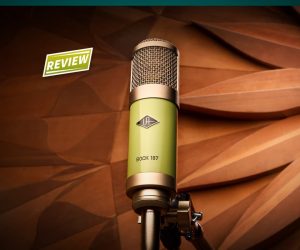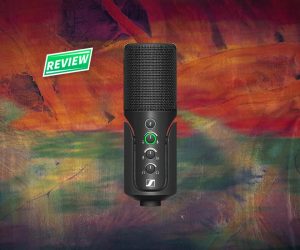
Review: L-Acoustics KUDO
An L-ACOUSTICS line source array anyone can buy? Christopher Holder takes a number and gets in line.
There’s no point trying to second-guess what L-Acoustics will do next. Back in 1993 the French innovators turned the PA market on its head with the release of V-DOSC. At the heart of the system was WST (Wave Sculpture Technology), which describes the unique geometry of the waveguide that allows V-DOSC to operate as a true line array all the way up to 16kHz – that’s why L-Acoustics trumpets the fact that V-DOSC is a line source array, not just a line array. Anyway, in the decade that followed, every other speaker manufacturer has had their customers demanding something to compete with V-DOSC. Conventional speaker systems have been sold off and binned in favour of line arrays. It was no longer respectable to hang a cluster of trapezoidal boxes… no sir, if you didn’t have a string of line array boxes you may as well not turn up.
LINE ARRAY OR NOTHING?
This one-size-fits-all fetish for line arrays must have bemused L-Acoustics somewhat. Not for a minute did they suggest that its large-format V-DOSC would be a PA ‘silver bullet’ – perfect for every application. And to see smaller PA hire companies traipsing off with four boxes of a competing brand’s line array – like they’re somehow a drop-in replacement for the equivalent quantity of 15+horns – is completely baffling.
Don’t get me wrong, V-DOSC was (and is) a complete eye-opener – at the time, the improvements in pattern control, throw and the consistency of sound across that coverage was phenomenal. But depending on how big a space you’re working in and how much vertical coverage you require, V-DOSC (which has a maximum 5.5° vertical coverage) inevitably requires a variety of complementary speakers for various fill tasks. That’s why L-Acoustics built products like dV-DOSC and ARCS – which are both WST-based systems.
So what L-Acoustics really needed was a product that had all the flexibility of a conventional trapezoidal rig combined with the sonic advantages of the Wave Sculpture Technology.
That product is KUDO.
THE KUDO DIFFERENCE
To give you an idea of where KUDO sits in the L-Acoustics family tree, physically (at 87kg) it’s in between dV-DOSC and V-DOSC. In terms of its SPL output, it offers 3dB more gain than an ARCS cabinet and 3dB less output power than a V-DOSC. Obviously it’s not in the same league as V-DOSC in that regard – it’s not built to be V-DOSC MkII, it’s very different. Let’s see how.
For starters you can array KUDO vertically or horizontally. When used as a vertical line source array (like V-DOSC) you’re not just constrained to the one horizontal coverage pattern. You can select between a tight 50° or a wider 110° coverage pattern. But not only that, there are two asymmetrical alternatives – 25° x 55° or vice versa (55° x 25°). What’s more, not all enclosures in the array need to be set to the same pattern, they can be mixed and matched (see diagrams on the opposing page). As far as vertical coverage goes, that’s a more standard affair of being able to adjust the inter-speaker splay angle (up to 10°) depending on your needs.
If you’ve elected to create a horizontal array with KUDO then you have the same sort of flexibility – there are the same four choices, only this time they describe the vertical directivity.
What with the four directivity settings and the two orientation possibilities you have one incredibly adaptable system. There are far more ways of covering your audience and avoiding the walls and ceilings without resorting to downfills, in-fills etc.
NEED TO KNOW
K-LOUVER
For a company like L-Acoustics that’s made its name fusing advanced mathematics with quality sound design, it’s quite interesting to see how it’s pulling off the variable directivity trick. No, it’s not some DSP-based sleight of hand, or another unique waveguide concept… it’s a mechanical device. That’s right! You’ve got to physically pull a lever and move a set of vanes (which they’ve coined the K-Louver – see diagrams).
Once you’ve done your room modelling and decided upon the best configuration of your KUDO array, then, while the speaker’s on the ground, you make the manual adjustments.
KUDO IN ACTION
When you hear KUDO in action it’s much like hearing V-DOSC. I attended a demonstration of KUDO at the John Batman Theatre in Melbourne’s Convention Centre and all the even coverage (frequency- and level-wise) you come to expect from L-Acoustics’ flagship products was evident. As was the precise directivity. There’s no question that KUDO is a Rolls Royce PA.
The big departure for L-Acoustics is that KUDO can be bought by anyone – unlike V-DOSC and dV-DOSC which is restricted to network rental partners – and the first time a WST line source array product has hit the ‘open market’. Which is just as well, because KUDO is aimed squarely at the likes of regional sound companies for touring or corporate applications, and is equally well-suited to install applications – clubs, churches, convention centres etc etc. In short, it’s a system that will have a million-and-one different applications.
As is L-Acoustics modus operandi, a KUDO system will be sold with all the associated brackets, leads, and amplification – features an ‘ergonomic captive rigging’ system (it’s all in the box). The idea here is that once you pay your money and get your system you can instantly take it out and use it. (L-Acoustics might be relaxing their stance on who gets to own their WST gear, but their not relaxing their stance on how you set it up for optimal performance.)
All up, there will be cheaper systems on the market, but few as useful and as sonically excellent as KUDO.
















RESPONSES